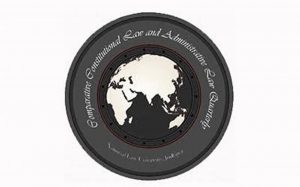The Comparative Constitutional Law and Administrative Law Journal Submission Guidelines
General Guidelines
- The Comparative Constitutional Law and Administrative Law Journal [“Journal”] attempts to initiate and foster academic dialogue concerning the subject of Administrative Law and Constitutional Law keeping in mind a global perspective. Please note that all submissions must be topical to the scope and theme of the Journal.
- All submitted manuscripts shall be original. Any form of plagiarism would lead to immediate rejection of the submission.
- Submission of solicited manuscripts, on invitation from the Journal’s editors, guarantees publication of the same. However, if such solicited manuscript does not meet the Journal’s standards of quality scholarship, final discretion to publish the solicited manuscript vests with the Editorial Board [“Board”].
- The author(s) must inform the Board if the manuscript has also been submitted to another journal, website or forum. The Board must be notified immediately if an offer for publication from another journal, website or forum is accepted by the author(s).
- After the first publication of a manuscript with the Journal, permission for any subsequent publication in another forum must be obtained from the Board.
- All correspondence must be via e-mail, and should be addressed to the Editorial Board at: editorcalq[at]gmail[dot]com.
Specific Guidelines
- Author(s)
- Each manuscript may have up to two authors, however co-authorship is not permitted for Book Reviews and Case Comments
- In case of joint authorship, the author from whom a submission is received by the Board, shall intimate the Board of the name, credentials and contact details of the intended co-author.
- Manuscripts
- The Journal accepts submissions in the following categories:
- Articles: Articles must deal with issues of interest and relevance and must demonstrate a high-level of analysis. Articles of a purely descriptive nature are not preferred.
- Notes: Notes should cover a recent development or should be issue specific. A Note functions as a more condensed and succinct Article.
- Case Comments: Case comments entail a critical analysis of recent case laws and policy developments.
- Book Reviews: Book Reviews entail providing a critical analysis and review of any book that deals with the subject matter of the Journal.
All manuscripts must necessarily be accompanied by an abstract of not more than 350 words.
- Word Count
- Articles- Not exceeding 10,000 (Ten Thousand) words.
- Notes- Not exceeding 4000 (Four Thousand) words.
- Case Comment- Not exceeding 3000 (Three Thousand) words.
- Book Reviews- Not Exceeding 2000 (Two Thousand) words.
Please note that the word limit would be considered excluding the footnotes, except when speaking footnotes are used. The journal may accept shorter or longer submission depending on the quality of the submission.
- Formatting Specifications
- The manuscript must be word-processed in Garamond.
- The main body text should be in font size 12 and footnotes in size 10.
- There should be line spacing of 1.5 between paragraphs and headings in the main body and a line space of 1.0 in footnotes.
- Verbatim quotes must be put in double quotes and italicized with a 0.5” indent.
- The entire document, including footnotes, must be justified.
- Language
The Journal shall follow British English.
- Citations and References
- All relevant sources shall be duly acknowledged as footnotes.
- Speaking footnotes are allowed.
- The text and citation styles shall conform to the rules prescribed in The Bluebook: A Uniform System of Citation (20th edition).
- Submission Procedure
- The Author/s are required to email the manuscript to editorcalq[at]gmail[dot]com.
- The manuscript may be mailed in Microsoft Word (‘.doc’ or ‘.docx’) format.
- The manuscript shall not contain any details of the author, and anonymity must be maintained.
- The subject of the mail must clearly mention, ‘Submission for CALQ_Volume 6.1 [Article/Note/Case Comment/Book Review]’.
- The mail must be addressed to the Editorial Board, providing the name of the author/s with the name of the institution affiliated to and the contact details in the body of the mail.
- A mail confirming the receipt of the manuscript and subsequently its acceptance for publication would be duly conveyed to the author/s through the email id used by the author/s for correspondence.
- The last date for submission is 11:59 p.m. (IST) on 15th August 2021.
Copyright Notice
Authors, upon submission, communicate their acceptance of the following conditions:
- The work, upon publication, becomes the property of the Journal.
- Permissions for subsequent publication/reprint and/or derivative works must be obtained from the Editors of the Journal.
Please visit www.calq.in for more information or write to the Editorial Board at editorcalq[at]gmail[dot]com in case of any queries.

